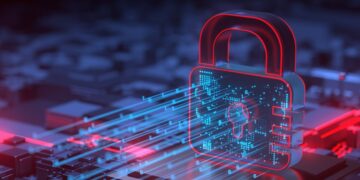The rapid advancement of artificial intelligence (AI) has transformed the digital landscape, revolutionizing how data is collected, processed, and analyzed. AI-powered tools enable businesses, governments, and individuals to harness vast amounts of information for decision-making, predictive analytics, automation, and cybersecurity. However, as AI becomes more sophisticated, it also introduces new and complex challenges to data security.
Cybercriminals are leveraging AI to launch more advanced and automated attacks, while organizations struggle to protect sensitive information against evolving threats. In an era where data is a critical asset, its security is paramount. AI has the dual role of both fortifying cybersecurity defenses and, paradoxically, increasing vulnerabilities. The very technology designed to enhance security can also be exploited by malicious actors.
Understanding data security in the AI era
As AI continues to evolve, its impact on data security becomes more pronounced. The integration of AI into various sectors necessitates a deeper understanding of the risks and mitigation strategies. Organizations must adapt to these changes by implementing stronger security frameworks and proactive measures.
The growing importance of data security
Data security refers to the practices, protocols, and technologies used to protect digital data from unauthorized access, corruption, or theft. With AI systems relying on massive datasets for training and operation, the need for robust data security has never been greater. These datasets often contain personal, financial, and proprietary information, making them lucrative targets for cybercriminals and vulnerable to misuse.
How AI is changing the cybersecurity landscape
AI has transformed cybersecurity by introducing sophisticated tools for detecting threats, automating responses, and predicting cyberattacks. However, it also presents new security challenges:
- Enhanced attack techniques: Cybercriminals are leveraging AI to develop more advanced malware, phishing attacks, and deepfake technologies.
- Data breaches and leaks: AI-driven systems require extensive data collection, increasing the risk of breaches.
- Privacy concerns: AI’s ability to analyze and correlate vast datasets raises ethical concerns about user privacy and consent.
- Bias and inaccuracies: Poorly secured AI systems can be manipulated, leading to biased decision-making and security vulnerabilities.
Major AI-related data security threats
The rise of AI introduces a new range of security vulnerabilities. Cybercriminals are leveraging AI to create more complex threats, making traditional security measures insufficient. Understanding these threats is crucial to developing effective defense mechanisms.
1. AI-powered cyberattacks
AI enables cybercriminals to launch more sophisticated attacks. AI-driven phishing schemes can generate highly personalized messages, making them more convincing. AI can also automate hacking attempts, allowing cybercriminals to identify and exploit vulnerabilities more efficiently.
2. Data poisoning attacks
Data poisoning occurs when malicious actors manipulate training data to alter AI system behavior. This can lead to biased AI models, security vulnerabilities, or incorrect predictions. For instance, poisoning a facial recognition system could allow unauthorized access or cause false positives.
3. Adversarial AI attacks
Hackers can exploit AI vulnerabilities by feeding manipulated data into machine learning models to trick them into making incorrect decisions. For example, attackers could trick an AI-powered security camera into misclassifying intruders as authorized personnel.
4. Unauthorized data collection and use
AI systems often collect and process large volumes of personal data. Without proper safeguards, this data can be exploited for unethical purposes, such as surveillance, targeted advertising without consent, or unauthorized profiling.
5. Weaknesses in AI-driven security solutions
While AI enhances security, it is not foolproof. Hackers can manipulate AI-based security tools by introducing misleading data, rendering threat detection systems ineffective.
Strategies for enhancing data security in the age of AI
To combat AI-driven security risks, organizations must adopt advanced security practices. By leveraging AI-powered security tools, enforcing regulatory compliance, and implementing robust cybersecurity strategies, businesses can safeguard their digital assets.
1. Implement strong encryption protocols
Encrypting data ensures that even if it is intercepted, it remains unreadable to unauthorized users. AI companies must prioritize end-to-end encryption, secure data storage, and robust access control measures.
2. Regular auditing and monitoring
Continuous monitoring of AI systems helps detect anomalies and potential security threats. Security audits should be conducted frequently to identify vulnerabilities before they can be exploited.
3. Data anonymization and differential privacy
To mitigate privacy risks, AI systems should utilize techniques like anonymization, where personally identifiable information is removed from datasets. Differential privacy ensures that AI models provide insights without exposing individual data points.
4. Adopting zero-trust security models
The Zero Trust model assumes that threats exist both inside and outside the network. Organizations must verify every access request before granting permissions, reducing the risk of insider threats and external breaches.
5. Defending against adversarial attacks
AI developers must design models resistant to adversarial attacks by improving model robustness, using adversarial training methods, and employing AI security frameworks that detect manipulated inputs.
6. Developing ethical AI practices
Regulatory frameworks and ethical guidelines must be established to ensure AI systems handle data responsibly. Governments and organizations should collaborate on policies addressing data privacy, AI transparency, and accountability.
7. AI-powered cybersecurity defense mechanisms
Using AI to combat AI-driven threats is essential. AI can enhance security through:
- Threat intelligence: AI-driven tools analyze attack patterns and predict future threats.
- Automated incident response: AI-powered systems can detect and neutralize threats in real-time.
- User behavior analytics: AI can identify suspicious activities by analyzing user behavior and flagging anomalies.
Future trends in AI and data security
The future of data security will be shaped by AI advancements. Innovations in AI-driven security tools, quantum-resistant encryption, and privacy-preserving AI will redefine how data is protected in an increasingly digital world.
1. AI-driven identity protection
Advanced AI algorithms will enhance identity verification systems, making authentication more secure through biometric security, behavioral analytics, and multi-factor authentication.
2. Quantum computing and its impact on encryption
While quantum computing offers potential benefits, it also threatens traditional encryption methods. Organizations must prepare for quantum-resistant encryption to safeguard sensitive data.
3. Legislative and regulatory developments
Governments worldwide are enacting stricter data protection laws. The European Union’s AI Act and updates to the General Data Protection Regulation (GDPR) highlight the growing need for AI regulation.
4. Federated learning for privacy-preserving AI
Federated learning allows AI models to be trained across multiple devices without sharing raw data, enhancing privacy and security in industries like healthcare and finance.
5. AI-augmented security teams
In the future, AI will complement cybersecurity professionals by automating routine tasks, enabling human analysts to focus on complex threats and strategic security initiatives.
Conclusion
As AI continues to shape the digital landscape, data security must evolve to address emerging threats and challenges. Organizations, governments, and individuals must adopt proactive measures, including robust encryption, ethical AI practices, and AI-driven cybersecurity solutions. By embracing a security-first mindset, we can harness AI’s potential while safeguarding data privacy and integrity in the digital age. The collaboration between policymakers, technology experts, and security professionals will be key in ensuring a safe and resilient digital future.


































































































































































































